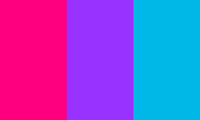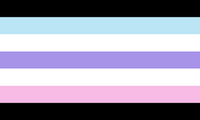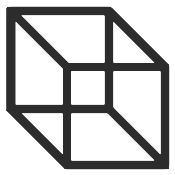Androgyne is a gender identity in which a person has a gender that is a blend of both binary genders. People who are androgyne may describe this as being "between" female and male, man and woman, masculine and feminine, or simply 'in between.' They may also identify as neither feminine nor masculine, or neither female nor male.[1] While included in the non-binary and transgender umbrella, androgyne people do not have to identify with either of those terms, as that is a personal decision.[2]
Etymology[]
The word androgyne is a portmanteau of two Greek words: "andró" meaning "man"[3], and "gynḗ" meaning "woman".[4]
Community[]
Some people who call themselves androgynes identify with androgynous gender presentations, or have or wish to obtain an androgynous, 'in between', or neutral body. Others see this as only a matter of gender identity and may express their androgynous gender through their personality or activities such as crossdressing. Some, but not all, androgynes experience gender dysphoria. As such, people might not relate to their sex assigned at birth, or find discomfort when others make assumptions regarding their gender or assigned pronouns. They may seek to transition to achieve a more neutral appearing body.
They can use any form of pronouns or neopronouns they like, even switching between pronouns (she/her, zhe/zhim) if desired, but most commonly, she/her and he/him tend to be used together interchangeably.
History[]
Historically, androgyne has been a word for an intersex person, and this use of the word is not completely obsolete. However, the sex of a person's body is different than their gender identity. Intersex is a physical sex, and androgyne can mean either that, or a gender identity.[5] The first instance of the term being used as a gender was in 1918, when Jennie June published Autobiography of an Androgyne,[6] which has since been described as "a centerpiece for queer, trans, and gender studies of twentieth-century America".[7]
There have also been instances of people using the term bisexual to refer to androgynes, androgynous people, or intersex people. An example of the use of this word, found in pop culture, is in the 50th episode of the 2nd season of Star Trek, "The Trouble with Tribbles", where Dr. McCoy refers to the tribbles (an alien species) as bisexual.[8]
Flags and symbols[]

The most common Androgyne Pride Flag

An alternative Androgyne pride flag
The most common androgyne flag, designed by Tumblr user saveferris on March 29, 2011,[9] has 3 colors. The pink supposedly represents femininity, the blue represents masculinity and the purple represents a combination of the both.[10]
There is an alternative flag, designed by pride-flags-for-us on Tumblr, with different colors and meanings behind each color. Androgyne has more of an attachment to the binary genders, thus the black and white of this alternative flag . The blue represents masculinity, and the pink represents femininity. Meanwhile, the purple represents a blending of masculinity and femininity. It also represents androgyne being a non binary identity.[11]

The Necker Cube symbol
The Necker Cube is an optical illusion that can look both concave and convex, first proposed as a symbol for the androgyne community by Cameron Reed[Note 1] in 1996.[12] It is a simple wire-frame, two dimensional drawing of a cube with no visual cues as to its orientation, so it can be interpreted to have either the lower-left or the upper-right square as its front side. For the androgyne community, the Necker Cube is symbolic of the androgynous individual’s physical ambiguity. It is used as an adjusted form of the Necker Cube with a smaller square in the center, as focusing on this square may allow the brain to break out of its cycle between two ‘equally possible interchangeable stable states’ and see the image for what it is; a two dimensional drawing which is neither of the interpreted cubes. Thus the androgyny symbol is itself an example of something that can be taken as one of two binary options or as something else entirely.[13]
Distinctions[]
Bigender[]
- Main article: Bigender
While bigender is a gender identity in which a person has or experiences two any co-existing genders, androgyne is a mix of the binary genders in particular. Bigender people have two genders, and these can be any two genders (including androgyne itself), but androgyne is one gender described as a blend of the two binary genders.[1]
Media[]
- Switch from The Matrix is described by the Wachowski sisters as a "beautiful androgyne"[14] in the original script and was originally intended to be played by two different actors, one inside the Matrix and another in the real world. Warner Brothers cut this particular idea, leaving actress Belinda McClory to play both roles.[15]
Notes[]
- ↑ The website used as a source here uses her deadname, due to them creating the website prior to changing their name. Her current name is used in this article.
References[]
|
